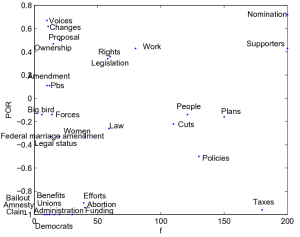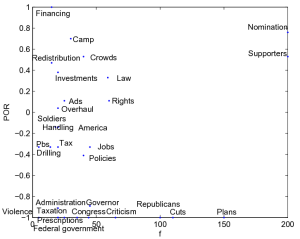The American presidential elections are among the most interesting campaigns because of the sheer amount of resources deployed and the influence of the United States on global governance.
This study presents a large-scale analysis of mass media coverage of the 2012 US presidential elections, combining automatic corpus linguistics methods and network analysis to obtain a network representation of the entire campaign coverage by the news media. Mapping the full extent to which an electoral campaign is represented by media offline and online constitutes a very difficult challenge for researchers, given the large amount of data and the multitude of sources available in advanced democracies. A paper about this project by academics at the University of Bristol’s Intelligent Systems Laboratory is due to be published in the Journal of Big Data & Society.
 |
 |
Caption: The network represents the actor network during the primaries phase (right) and main elections phase (left) of the elections. Nodes in the graph are actors or issues and the edges linking them represent statements of the subject-actor about the object-actor and the color indicates if the statement is positive (green) or negative (red). The links are also assigned positive or negative weights. Finally, the size of the node reflects the prominence of the corresponding actor in the media narrative.
 |
 |
Caption: The two networks represent networks of the main candidates Obama and Romney during the main election phase.
Analysing the media coverage of the US election using our big-data approach revealed the strategic positioning of actors around issues in the ‘mediascape’ of online English-language news. We used a semantic graph obtained by parsing the text, identifying the noun phrases and the verbs and linking them, and used subject-verb-object triplets as building blocks for a network. This approach is innovative and has never been applied to a real-world dataset of this scale. Using media data and transposing signed relationships in a graph we uncovered the unique mixture of endorsements and disapproval that constitute the Republican and Democratic camps. It is a remarkable finding that the spectrum of political positions can be reliably recovered from the set of claims attributed to each actor by the media reporting. The split of the network into the two main camps provides strong evidence that the main political relations can be extracted by this approach.
 |
 |
Caption: The scatter plots show the positive object ratio of issues and actors in Obama’s (right) and Romney’s(left) campaign. The x axis shows the frequency of the actor or issue mentions with respect to triplets extracted during the main elections. We see that Obama was very positive about `Economy’ related issues, and also both the candidates were against `Taxation’.
Also by analysing the individual campaigns of the main candidates Obama and Romney their campaign representations in the media could be studied. Results suggest that the 2012 campaign was characterised by Obama’s strategy of defending his record on the economic policy and ‘owning the issue’, by his being ‘on the attack’ about a number of issues and forcing Romney and the Republicans to be defensive about salient issues. The set of triplets show that the 2012 campaign was very much focused on the issues of the US economy and civil rights for the Democrats. The agenda-setting effort was directed towards these two areas. Obama challenged the traditional Republican issue ownership about the economy. Overall, media reporting contained more frequently positive statements about the Democrats than the Republicans. Overall, the Republicans were more frequently the object of negative statements either by Democrats or other actors. The Republican Party (GOP) is the most divisive subject in the campaign, and is portrayed in a more negative fashion than the Democrats.
This study was made possible by the use of a computational infrastructure for the collection and analysis of ‘Big Data’ representing an example of the application of techniques to gain insight about societal phenomena. Artificial Intelligence and text mining techniques were used to detect election-related articles, parse their content, extract the key actors in a narration and their relations, forming a network whose topology has then been analysed. We believe that our methodology represents a substantial step forward in the linguistic analysis of texts by means of extracting relational data.
Journal Publication: Big Data & Society, Natural Language Engineering
Conference Publication: EACL 2012, IPP 2012
